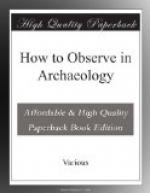Cretan influence strong in Middle Minoan completely drowned local efforts in first Late Minoan days. Thenceforward local ware imitative.
South Greece.
Neolithic. Nothing known.
Bronze age.
Geometric Ware with matt paint and pale clay corresponding
to that of
islands found in Argolid and Boeotia.
‘Urfirnis’ Ware. Hand-made. Whole vase covered with thin semi-lustrous wash varying from red-brown to black. Sometimes mere smears. Mainly found in Boeotia, but extends north to valley of Spercheius and south to Argolid. Date uncertain, but in Boeotia evidence that it ended before rise of ‘Minyan’ ware.
‘Minyan Ware.’ Grey unpainted pottery, polished. No decoration except (rarely) incised lines. Usually wheel-made. Characteristic shapes: Goblet with tall ringed stem (III, Fig. 15); wide open cup with high handles.
Appears to range Between Middle Minoan ii and Late Minoan III.
Most frequent in Boeotia to which it owes its name. Found as far north as Thessaly and as far south as Crete. Local imitations, obvious but distinct, found with imported specimens (Melos). Provenance unknown; connexion with Troy suspected.
‘Mycenaean.’ The Cretan civilization swept over South Greece in the first Late Minoan period. Characterized by exuberance both in shape and ornament (III, Figs. 11, 12, 13, 16, 17). Bulk of what is likely to be found is of latest period when style has become conventionalized. Compare Fig. 11 (Mycenaean) with III, Fig. 7 Late Minoan I. Characteristic shapes high goblet and ‘stirrup’ vase (III, Figs. 17 and 16).
Female clay figurines common (III, Fig. 14), also animals, oxen.
Objects Characteristic of Aegean Civilization.
Seal Stones. Round or bean-shaped, pierced for suspension, usually soft stone, e.g. slate or steatite. Sometimes hard, as hematite or rock crystal. Carved with naturalistic designs: lions, (III, Fig. 8), stags, bulls, cows or hinds suckling their young, cuttle-fish, dolphins, &c. Two animals ranged like heraldic supporters characteristic.
Obsidian. Natural glass, volcanic, black. Source Melos. Used for knives throughout Bronze Age.
Chips of Knife or razor blades, and sometimes the cores from which these were flaked, may be picked up on any Bronze Age site, and even on Thessalian neolithic settlements. Glistening black unmistakable.
Terra-cotta lamps. The characteristic lamp of the Aegean civilization is open, as opposed to the Greek and Roman lamp where the body is partly covered in.
Walls. Cyclopean walls of huge irregular stones. Also good square-cut masonry.
‘Corbelling’ system for arches, each layer of stones projecting inwards over the one below. Also used for the vaults of ‘Beehive’ Tombs towards end of period.
[Illustration III: Types of Greek pottery, etc.]




